Physical Address
304 North Cardinal St.
Dorchester Center, MA 02124
Physical Address
304 North Cardinal St.
Dorchester Center, MA 02124

Almost one small swap a week can add up: research shows modest shifts in meals and plates lead to real gains in weight control, blood sugar, and heart markers over months.
Start with tiny moves—use smaller plates, eat vegetables first, and chew more slowly so fullness has time to register. These simple steps cut calories without feeling deprived.
Swap refined grains for whole ones, pick sparkling water over soda, and bake instead of frying to lower empty calories and reduce harmful compounds like AGEs and PAHs. Plan shopping with a list and avoid shopping hungry to stop impulse buys.
Cooking more at home gives better control of ingredients and links to improved diet quality. Treat these actions as practical ways to support long-term goals, not quick fixes.
One simple change each day—like picking whole grains or water—adds up into real health gains over a week.
Small swaps deliver quick wins: choose brown rice or whole-wheat pasta to boost fiber and micronutrients. Replace sugary beverages with still or sparkling water to cut empty calories. Cook at home to control ingredients and lower total calories versus takeout.
Eating slowly helps your brain register fullness in about 20 minutes. Planning one new healthy recipe per week keeps meals interesting and improves diet quality over time.
| Swap | Immediate benefit | Why it helps |
|---|---|---|
| Soda → Sparkling water | Fewer calories | Cuts sugar, keeps flavor with bubbles |
| White rice → Brown rice | More fiber | Slower energy release, greater fullness |
| Takeout → Simple home meal | Lower calories | Portion control and cleaner ingredients |
How you arrange food and the speed you eat affect hunger signals and overall calorie intake. Small visual and timing shifts help the body register fullness and support weight goals without strict counting.
Use smaller plates to keep portions visually full. Research links downsized dinnerware with higher satiety and lower energy intake, often without eating more later.
Swap large dinner plates for 8–9 inch versions. The plate still looks full, but total serving sizes fall. This simple change preserves satisfaction while trimming calories.
Front-load non-starchy vegetables at the start of meals. Eating vegetables before carbs helps moderate sugar levels and can lower how much you eat later in the same meal.
Ask for sauces on the side and measure a serving with a spoon. This makes it easier to limit added calories and excess salt while keeping flavor options.
Set your fork down between bites and chew thoroughly. It takes about 20 minutes for fullness hormones to reach the brain, so a slower pace often means fewer calories per meal and better weight control.
Simple plating rules: plate protein and vegetables first, follow a half-plate veg, quarter protein, quarter whole grains visual, and portion snacks into a single serving before you start.
| Strategy | Action | Immediate benefit |
|---|---|---|
| Smaller plates | Switch to 8–9 inch dinnerware | Lower calories without losing satiety |
| Veg-first plating | Serve non-starchy vegetables first | Steadier blood sugar levels and reduced intake |
| Condiments on side | Measure dressing with a spoon | Fewer added calories and less salt |
| Slow pace | Put fork down between bites; chew more | Gives brain ~20 minutes to register fullness |
Smart grocery planning makes it easier to cook more at home and control ingredients. Plan a short written list and avoid shopping when hungry to reduce impulse buys and keep better foods in your cart.
Cook more nights to manage portions, lower cost, and improve diet quality. Try one new healthy recipe each week to build skills and keep meals interesting.

Prefer baking, poaching, stewing, or pressure cooking over frequent frying or high-heat grilling. Research shows lower formation of harmful compounds with gentler methods.
| Swap | Action | Benefit |
|---|---|---|
| Frying | Bake or poach | Fewer AGEs and HCAs |
| Processed “diet” foods | Whole foods | Less added sugar and sodium |
| No plan | List + routine | Lower energy intake and better food choices |
Read labels to spot hidden sugar and salt. Small changes in shopping and cooking can cut added sugar, control intake, and support long-term weight goals.
Choosing protein first and water with meals often reduces later snacking and excess intake. Small swaps at each eating moment cut empty calories while keeping flavor and satisfaction.

Build breakfast around protein. Eggs or plain Greek yogurt boost satiety and curb sugar cravings later in the day.
Pack lean proteins, extra vegetables, and a whole-grain base. Swap chips for a small serving of unsalted nuts or carrot sticks to lower calorie load.
Choose whole-wheat pasta with tomato-based sauces and add veggies. Keep cheese light; herbs and spices add flavor with fewer calories.
Put water first at meals and favor black coffee or a skim “skinny” option to avoid added sugar and cream. Limit fruit juice to a small serving and prefer whole fruit.
Pre-portion snacks. Air-popped popcorn and fresh berries beat chips and dried fruit for lower sugar and higher fiber per serving.
Focus on adding quality protein and fiber at each meal to boost fullness and steady energy. Small shifts in ingredients can raise nutrient density without big effort.

Include a protein source with breakfast, lunch, and dinner—eggs, Greek yogurt, beans, nuts, lean meat, or dairy. Research shows higher-protein meals lower ghrelin and can modestly increase daily energy expenditure.
Aim to add fiber-rich foods like lentils, raspberries, oats, broccoli, and popcorn. Most adults fall short of targets; women under 50 should aim for about 25 g/day, men about 38 g/day. Increase water as fiber rises to ease intake and support regularity.
Use extra virgin olive or avocado oil for cooking and dressings, and limit refined seed oils high in omega-6. If you rarely eat fatty fish, consider an omega-3 option. Build plates around vegetables, then add protein and whole grains for a nutrient-rich diet.
Small label checks can reveal surprising amounts of salt and sugar that drive extra calories and increase long-term risk for hypertension and heart disease.
The American Heart Association recommends aiming for ≤2,300 mg sodium per day, with 1,500 mg ideal for extra heart protection.
Many deli meats, canned soups, sauces, and snacks are high in salt. Choose low-sodium versions and use lemon, garlic, cinnamon, and salt-free blends to keep flavor.
Measure snack servings and use smaller bowls to control calories and sodium intake.
Keep a detailed two-week log of everything you eat and drink. A diary often exposes sugar in flavored yogurts, sauces, cereals, and beverages.
Use that data to set one swap per week—replace a sweetened drink with water or sparkling water to cut empty calories that add to weight and disease risk.
Whole fruit adds fiber and slows sugar absorption compared with juice, which can spike blood sugar. If you drink juice, limit it to a small serving and pair it with protein.
| Action | Why it helps | Tip |
|---|---|---|
| Swap sweet drinks | Fewer empty calories | Choose water or sparkling water |
| Pick low-sodium products | Lower daily salt | Compare mg per serving on labels |
| Log for two weeks | Find hidden sugar sources | Set one realistic swap per week |
,
Good sleep and regular movement make appetite signals clearer. Adequate sleep lowers cravings, helps glucose control, and supports weight and weight loss goals.
Build physical activity into the day with short walks, stairs, or a 30-minute session most days to boost mood and energy. Keep water in reach and swap sweet drinks to cut calories and steady intake.
Try a simple morning ritual: a balanced breakfast, a quick plan for meals, and coffee early in the day without sugary add-ins. Store tempting foods out of sight and keep vegetables and proteins prepped and visible.
Track non-scale wins—better sleep, steadier energy, stronger workouts—and revisit the plan weekly. Small, repeatable changes over months lower heart disease risk and help people lose weight without burnout.